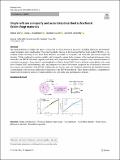Single cells are compactly and accurately described as fractional Kelvin-Voigt materials
Author(s)
Das, Mohua; Waeterloos, Jarno L.; Clasen, Christian; McKinley, Gareth H.
Download397_2025_Article_1515.pdf (1.614Mb)
Publisher with Creative Commons License
Publisher with Creative Commons License
Creative Commons Attribution
Terms of use
Metadata
Show full item recordAbstract
The mechanobiology of single cells plays a crucial role in various biological processes, including embryonic development, cancer treatment, and wound healing. This study highlights the use of the fractional Kelvin-Voigt model (FKVM)—a viscoelastic model consisting of two Scott Blair elements in parallel—to compactly and accurately characterize single-cell rheology. Unlike traditional power law models, which primarily capture the key features of the mechanical response at long timescales, the FKVM effectively captures both short- and long-timescale mechanical responses with a minimal number of constitutive parameters. Experimental small-amplitude oscillatory shear (SAOS) data for dividing canine kidney cells, creep data of human K562 erythroleukemic cells, and creep recovery data of blastomere cytoplasm are all analyzed to showcase the accuracy and versatility of the FKVM. Additionally, for the first time, the continuous relaxation and retardation spectra corresponding to the fractional differential formulation of the FKVM are derived. These results establish a comprehensive framework for predictive analysis of single-cell rheology in both the time and frequency domains. Graphical abstract
Date issued
2025-08-25Department
Massachusetts Institute of Technology. Department of Mechanical EngineeringPublisher
Springer Berlin Heidelberg
Citation
Das, M., Waeterloos, J.L., Clasen, C. et al. Single cells are compactly and accurately described as fractional Kelvin-Voigt materials. Rheol Acta 64, 407–421 (2025).
Version: Final published version